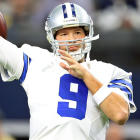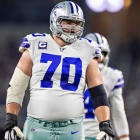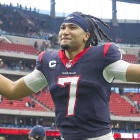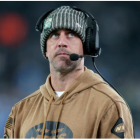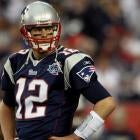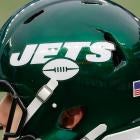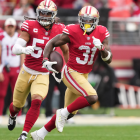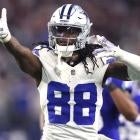It’s time to dispel the some of the misconceptions regarding Tony Romo’s playing career.
He unquestionably was one of the very best quarterbacks of his 10-year run as a starter in the NFL, and one of the game’s toughest players. He was one of the more compelling stories to emerge of his era, going from an undrafted college free agent out of Eastern Illinois to unseating Drew Bledsoe as the Cowboys’ starter a few years later and forging one of the more illustrious careers in that high-profile franchise’s history.
Romo was anything but a choker, or someone who couldn’t be trusted late in games. He was very much a gunslinger and someone not afraid to try to win the game and take command. He always played with that air of a Brett Favre, willing to get burned a time or two because of it -- but he was hardly the interception machine some paint him to be. He was one of the more dynamic and daring players of his time who fared much, much better in the big moments than groupthink would have you believe.
He was an instinctive, selfless leader and one of the greatest performers in Cowboys history. He was far more effective in the postseason than you most likely think, and he walks away from his playing career two seasons removed from a 2014 campaign that was in every way MVP worthy. As my colleague Pete Prisco noted, Romo is one of the most misunderstood and least-appreciated players of this generation, and someone who I suspect history smiles upon far more than the media and fans ever do, given the breadth of his career.
I won’t lie -- as much as I am thrilled to be able to call Tony Romo a CBS colleague and as pumped as I am to work with him on occasion and for as strong an analyst as I believe he will become, I wasn’t ready to stop watching him throw on Sundays. I didn’t want this to end this way, without another chance to bask in the warmth of Opening Day with a team’s fortunes riding on his shoulder and another shot at postseason glory. Another chance to try to stay healthy and productive.
But also am the last person ever to question anyone’s decision to leave this game. I fully understand the physical toll it requires to withstand a single full-padded training camp practice, having stood mere feet away from the contact too many times to count, much less the rigors and risk endured during a full season. And with Romo’s 37th birthday weeks away -– exactly one week after my 43rd birthday -- I can only imagine the aches and pains and strains that go with him getting out of bed, and I never did anything beyond playing high school hockey.
So it’s time to celebrate what Romo’s on-field accomplishments and separate fact from fiction. Let the numbers be our guide to appreciate what Romo did while remembering he took the reins at the height of Dallas dysfunction. It came before the steadying hand of Stephen Jones started to calm his father’s impulses. And this was peak Jerry Jones, unshackled by Jimmy Johnson, willing to run off a Bill Parcells and at his most unbridled willing to chase a Terrell Owens with no checks and balances. This was a quarterback who almost never had support from his defense, who played with a revolving door of running backs in the post-Emmitt Smith Era and who didn’t even get a dalliance with Zeke Elliott in his final season. Dak Prescott already is the beneficiary of a balance of infrastructure the likes of which Romo rarely, if ever, knew.
Romo posted a passer rating of 95 or better in eight of his 10 seasons as a starter. He threw for more than 4,000 yards -- cresting with 4,903 yards in 2012 -- in four seasons. He tossed 30 or more touchdowns in four seasons and it’s easy to forget he threw a career best 36 in only his second year as a starter after displacing Bledsoe, who had a long history with Parcells, who was then the coach. Nor should we overlook Romo’s career completion percentage of 65 percent.
By any metric, Romo was at the pinnacle of his profession during his time as a starter. No matter how you slice it, it’s Aaron Rodgers, Tom Brady, Drew Brees, Peyton Manning and Romo in terms of quarterback excellent from 2006-16, which we’ll dub The Romo Years for the purpose of this exercise.
During The Romo Years (2006-2016) among all QBs to attempt at least 3,000 passes, here is how Romo stands in key categories:
| Player | TD | INT | Rating | |
|---|---|---|---|---|
Aaron Rodgers
GB QB
| 62 | 23 | 99.7 | |

Drew Brees
NO QB
| 92 | 43 | 98.5 | |
Peyton Manning
DEN QB
| 62 | 28 | 98.2 | |
Tony Romo
DAL QB
| 64 | 27 | 96.2 | |
Tom Brady
NE QB
| 59 | 24 | 94.9 | |
| Player | TD Percentage | | | |
|---|---|---|---|---|
Aaron Rodgers
GB QB
| 6.4 | | | |
Tom Brady
NE QB
| 5.9 | | | |
Peyton Manning
DEN QB
| 5.8 | | | |
Tony Romo
DAL QB
| 5.7 | | | |
| Player | Yards per attempt | | | |
|---|---|---|---|---|
Aaron Rodgers
GB QB
| 7.92 | | | |
Tony Romo
DAL QB
| 7.89 | | | |
| Player | Completion percentage | | | |
|---|---|---|---|---|

Drew Brees
NO QB
| 67.8 | | | |
Peyton Manning
DEN QB
| 66.5 | | | |
Tony Romo
DAL QB
| 65.3 | | | |
For individual seasons, again, consider Romo in 2014. It was fairly magical for the field general of a flawed team with an incomplete roster, and it was Romo vs. the world most weeks. The offensive line, now the best in the game, was nowhere near that then and still a draft priority. Neither side of the ball was as robust as Dallas boasts today. But since Romo took over as a starter in 2006, only five individual campaigns surpass it from a statistical perspective.
| Player | Year | Touchdowns | Interceptions | Rating |
|---|---|---|---|---|
Aaron Rodgers
GB QB
| 2011 | 45 | 6 | 122.5 |
Nick Foles
PHI QB
| 2013 | 27 | 2 | 119.2 |
Tom Brady
NE QB
| 2007 | 50 | 8 | 117.1 |
Peyton Manning
DEN QB
| 2013 | 38 | 7 | 117.1 |
Tony Romo
DAL QB
| 2014 | 38 | 5 | 113.2 |
Bear in mind, Brady, Manning, Brees and Rodgers have been throwing the football in their prime during this 10-year stetch (aka The Romo Years) but each has managed only one year that transcends Romo’s final full campaign as a starter.
Then there is the notion of Romo the game-blower. Romo the turnover maker. All that neglects the herculean effort it often took to keep the Cowboys in many of these games, but even discarding that reality, the numbers simply don’t tell the story many (most?) anticipate.
From 2006-16, Romo was the league’s premier quarterback in fourth-quarter situations when the score difference was seven points or fewer. Yes, you read that sentence correctly. In his career, in those situations, Romo was 400 of 618 (64.7 percent) for 5,335 yards (8.63 per attempt!) with 42 TDs to 18 INTs and a sparkling rating of 102.5. By comparison, Rodgers had a rating of 101.2 in those situations in that timeframe and Manning was next at 99.5.
What about the fourth quarter overall in that span, since, you know, Romo always was blowing games. So maybe his team was already down by more than a TD, right? OK, overall fourth-quarter production from 2006-16:
| Player | Percentage | TD/INT | Yards/attempt | Rating |
|---|---|---|---|---|
Aaron Rodgers
GB QB
| 63.7 | 75/24 | 8.03 | 103.2 |
Tony Romo
DAL QB
| 65.2 | 75/30 | 8.38 | 102.7 |
Tom Brady
NE QB
| 62.6 | 80/25 | 7.62 | 98.3 |
Hmmm, but that’s not what we’re all led to believe, right? So let’s break it down into games in which a QB’s team trailed by 1-7 points and look at all of his attempts in those situations. So, of everyone who attempted at least 1,000 passes in such situations from 2006-16, here’s where Romo stands:
| Player | TD | INT | Rating | |
|---|---|---|---|---|
Aaron Rodgers
GB QB
| 62 | 23 | 99.7 | |

Drew Brees
NO QB
| 92 | 43 | 98.5 | |
Peyton Manning
DEN QB
| 62 | 28 | 98.2 | |
Tony Romo
DAL QB
| 64 | 27 | 96.2 | |
Tom Brady
NE QB
| 59 | 24 | 94.9 | |
But what about games in which the quarterback’s team was winning by 1-7 points at any point? Because, come on, we all know that Romo was always blowing games:
| Player | TD | INT | Yards/attempt | Rating |
|---|---|---|---|---|
Aaron Rodgers
GB QB
| 73 | 13 | 8.08 | 107.3 |
Tom Brady
NE QB
| 89 | 19 | 7.98 | 105.2 |

Drew Brees
NO QB
| 88 | 30 | 7.98 | 104.5 |
Tony Romo
DAL QB
| 52 | 22 | 8.28 | 100.9 |
Hardly poor company to keep.
Finally, since we’ve avoided the elephant in the room: the notion Romo couldn’t get it done in the playoffs. I mean, if only he had the ability of a Eli Manning or Joe Flacco to find another gear in January. If only he were wired that way. But that would require some fuzzy math, too. Yes, Romo appeared in only six postseason contests, and that’s a smaller-than-ideal sample size, and yes he famously fumbled a snap on special teams. But he also sports a career passer rating of 93 in the postseason, with eight TDs to only two picks, while averaging more than 7 yards per attempt. Eli Manning has a career rating of 91.3 in 11 postseason games (18 TDs to 6 INTS) and Flacco stands at 88.6 in 15 playoff games (25/10).
It goes without saying that those two quarterbacks have tasted the ultimate glory of hoisting the Lombardi Trophy, and doing so as the Super Bowl MVP no less, certainly as lofty a pedestal as exists in the NFL. Alas, Romo won’t ever reach those heights, though who knows how many Super Bowls he might call from the broadcast booth?
But any reasoned analysis of Romo compared to his peers reveals a man who is among the very best QBs of his era, who soared to a level few would have ever predicted given his humble football roots. If Prescott turns in anything close to this kind of career, he very well may have multiple rings to show for it. That remains to be seen if that will be the case, and Prescott walked into a climate and locker room quite different from the 2006 Dallas Cowboys and unlike anything Romo ever experienced.
Romo’s career was a far more clutch and storied than many seem willing to admit, and one that will only look better through the portal of time as he remains very much a part of the fabric of NFL Sundays.














